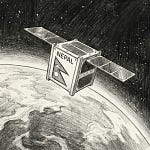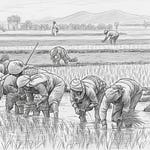Share the love! Help others that care about Nepal stay up to date the easy way. If you like this issue, share it with a friend who follows Nepal and hit Subscribe for your weekly dose of curated, can’t-miss updates.

As the lights of Tihar dimmed and families across Nepal bid farewell to the five-day festival of joy, this week asked us fundamental questions about who we are and who gets to belong. From heated debates over Tashi Lhazom’s “Nepali-ness” exposing the ugly fault lines of ethnic nationalism, to desperate migrants spending millions only to face deportation at America’s gates, to Parbat farmers earning Rs 650 million from agricultural exports (oranges alone brought in Rs 248 million), to our athletes claiming silver medals on Spanish mountains and cricket victories that stunned the world—this edition captures a nation caught between fading festival lights and harsh political realities, between economic turbulence and homegrown triumphs, between celebration and tragic loss. As Prime Minister Karki navigates fractured politics toward March elections, one truth emerges: Nepal’s resilience isn’t found in any single definition of identity, but in the collective strength of all its people, whether they’re running mountain trails, harvesting orange orchards, or lighting butter lamps and hoping for better days ahead.
Politics & Governance 🏛️
The most provocative debate this week centered on questions of Nepali identity itself. When rumors surfaced about Tashi Lhazom’s potential appointment to the Cabinet as a Gen Z representative with climate expertise, social media erupted with questions about her citizenship and background. THT reported that the controversy exposed deep-rooted patterns of discrimination that have plagued Nepal’s political discourse for generations. Political analyst Binay Mishra noted that “non-Nepali speakers have been others in the grand narrative of Nepali nationality,” explaining that the Khas Aryan community’s dominance has fueled a nationalist ideology that repeatedly pushes indigenous Janajati, Madhesi and Dalit communities to prove their “Nepali” identity. The backlash against Tashi echoed similar scrutiny faced by Dr. Sangeeta Mishra, who was dropped as a ministerial candidate amid citizenship questions despite holding naturalized citizenship after marrying into Nepal. Social media users drew stark parallels to how Rabi Lamichhane, president of the Rastriya Swatantra Party, was simply reelected after relinquishing his US citizenship, while Madhesi and northern indigenous communities face persistent demands to prove their credentials. “When the Madhesis from the south progress, they say ‘Indian’ and ask about their citizenship,” wrote one Facebook user. “When the indigenous of the north try to progress, they term them ‘Tibetan’ and ask for their citizenship. Only those who live in this ‘in-between’ are truly patriotic and true citizens.” Tashi herself told media that “she wouldn’t have to deal with the current circumstance if she had come from Khas Aryan.” The controversy revealed what Mishra called a fundamental truth: “In the cases of Sangeeta Mishra and Tashi, both of them are not representative of what is considered 24-carat Nepali”—a damning indictment of how linguistic and ethnic parochialism continues to define national belonging in modern Nepal.
Meanwhile, Prime Minister Sushila Karki held her first major all-party meeting on October 21, bringing together representatives from seven political parties to build consensus for the March 5 election. THT reported that the five-hour discussion at Baluwatar covered election preparations, corruption control, and security concerns. Communications Minister Jagdish Kharel described it as “a very positive discussion,” noting that most parties showed support for moving forward with elections. The government continues juggling multiple responsibilities—from recovering weapons looted during the Gen Z protests to investigating the violence of September 8-9, while trying to maintain political dialogue and build trust across the fractured political landscape.
On the accountability front, the CIAA filed corruption cases against 14 officials including former Health DG Sangeeta Kaushal Mishra, who had been considered for health minister before the charges surfaced. The case involves Rs 140 million in irregularities related to mammography equipment procurement, with fake invoices and no formal contract signed. THT noted the CIAA is seeking Rs 146.85 million in recovery. Meanwhile, CPN-UML Chair KP Sharma Oli continued his offensive against the government, visiting his burned Balkot residence and declaring the current administration “unconstitutional,” while refusing to cooperate with the Gauri Bahadur Karki-led probe commission. Political tensions remain high as Gen Z groups show signs of fragmentation—police detained 50 members of “Gen Z United” for protesting at Maitighar without permission, demanding a central Gen Z conference, while Sudan Gurung’s faction urged focus on “those who ordered shootings, not burned Singha Durbar,” highlighting the delicate balance between movement energy and institutional order as the nation heads toward crucial elections.
Diaspora & Globalisation
While political debates raged at home about who counts as “truly Nepali,” the diaspora confronted far darker realities of migration gone wrong. MyRepublica published a devastating investigation into the human trafficking networks exploiting desperate Nepalis dreaming of American prosperity. The report detailed how a young man from Dang spent Rs 8.26 million—mortgaging property and borrowing from relatives—only to endure captivity in Mexico, traversal through a dozen countries, and immediate arrest upon reaching US soil. “I cried a lot, but the police didn’t remove the handcuffs,” he recalled of his arrival. The story is tragically common: 468 Nepalis have been deported from the US so far, with 243 sent back just since Donald Trump’s re-election. The Anti-Human Trafficking Bureau reports that western Nepal, particularly Dang and Rukum, has become fertile ground for traffickers charging between Rs 4.5 million and Rs 10 million, often abandoning migrants mid-journey. SSP Krishna Pangeni noted that “there is a highly organised network behind sending people to the US illegally,” driven by poverty, unemployment, and peer influence. The irony is stark: while some Nepalis face relentless questioning about their citizenship at home, others are spending fortunes and risking their lives for the mere chance to live as undocumented workers abroad.
In quieter but no less concerning news, 34-year-old Jitendra Pandey from Tanahun went missing in Portugal’s Sintra area on October 14. His colleague reported that Pandey, who had been working at a packing company for two years, left his house saying a friend had called him and hasn’t been heard from since. Rising Nepal noted that Pandey called a relative that morning saying “he would be out of touch for a few days,” but all his belongings—residency card, bank card, passport—were found in his room. The week also brought closure to a two-year ordeal when Bipin Joshi’s body was finally returned from Israel after he was killed in Hamas captivity. Prime Minister Karki paid tribute, calling him “a brave son of Nepal,” and his funeral was held with state honors at Bhujela Ghat on the Mahakali River. Meanwhile, the Pakistani Embassy distributed humanitarian relief to flood survivors in Ilam where 37 people had died in October landslides, with Ambassador Abrar H. Hashmi emphasizing “the need for strengthening the longstanding friendship and cooperation between Nepal and Pakistan”—a reminder that even as Nepalis abroad face vulnerability and tragedy, regional neighbors sometimes step up with unexpected support.
Economy & Development 💸
After weeks of soaring to record highs, Nepal’s economy showed signs of volatility and mixed performance. The country’s commercial banks saw net profits decline by 6.18 percent in the first two months of the fiscal year, slipping from Rs 17.69 billion to Rs 16.59 billion amid sluggish business and rising non-performing loans. MyRepublica reported that Global IME Bank topped profit earners with Rs 1.62 billion, while Himalayan Bank witnessed the steepest decline of 68.26 percent. The banking sector’s struggles reflected broader economic challenges, with deposit interest rates falling to 5.1 percent from 5.37 percent. The stock market told a similar story—investors lost Rs 159 billion as the NEPSE index plummeted almost 4 percent in a single week. Gold prices demonstrated dramatic swings: after surging Rs 23,000 per tola to hit a record Rs 258,000 per tola, prices suddenly dropped Rs 4,800 as international markets cooled.
Yet amid financial turbulence, bright spots emerged from unexpected corners. Parbat district achieved a remarkable milestone in agricultural self-reliance, earning over Rs 650 million from agricultural exports in fiscal year 2081/82. THT reported the district produced 72,950 metric tons of food grains, with oranges alone generating Rs 248.4 million. Farmers in Kanchanpur were making Rs 90,000 per season from zero-tillage garlic cultivation. Infrastructure victories dotted the landscape: the Kaligandaki Corridor completed a crucial 25-meter motorable bridge over Setokhola stream in Mustang, ending the need to ferry vehicles across the river. The Khandbari-Kimathanka road reopened after 80 days of landslide clearance, while two major hydropower projects on the Rahughat River—the 35.5 MW Chimkhola-Rahughat-Mangale and 48.5 MW Upper Rahughat—completed construction and began commercial production.
Other developments painted a picture of a nation pushing forward despite challenges: Fusemachines, the AI company founded by Nepali entrepreneur Dr. Sameer Maskey, began trading on NASDAQ under the symbol “FUSE,” becoming the first Nepali-origin company to achieve this milestone. The Nepal Electricity Authority moved decisively against 24 industries defaulting on electricity dues totaling over Rs 8 billion, cutting power to companies including Jagadamba Steel and multiple cement factories—a bold enforcement action delayed since 2018. The Kathmandu-Terai Expressway reached 43.6 percent physical completion with officials insisting it would meet its April 2027 deadline without cost overruns. Preparations intensified for COP-30 in Brazil, where Nepal plans to present nine key agendas including the Sagarmatha Call for Action on mountain protection and climate finance, while the Tihar Flora Expo concluded with Rs 10 million in turnover and 35,000 visitors.
Social & Cultural ⭐
Nepal’s rich tapestry of festivals took center stage this week as the nation celebrated Tihar, the five-day festival of lights that illuminated homes and hearts across the country. The festival began with Kaag Tihar on October 19, when families offered rice mixed with curd to crows—believed to be messengers of Yamaraj—while chanting “Shuva bol, shuva bol” (bring good news). Artist Ramesh Dulal held his 22nd annual “Crow Conference” at Narayanhiti Palace Museum, using his unique talent to imitate crow sounds and call hundreds of crows to the venue. MyRepublica reported that Kukur Tihar followed on the third day, with dogs across Nepal receiving garlands, tika, and special treats. The main celebration of Laxmi Puja on October 21 saw devotees worshipping the goddess of wealth with homes illuminated by thousands of butter lamps, while markets buzzed with flower buyers—Sayapatri marigolds surged to Rs 1,000 per kg and Makhamali garlands reached Rs 100 per piece. The festival continued with Gai Puja and Govardhan Puja, honoring cows as symbols of Goddess Laxmi, before culminating in Bhai Tika on October 24, when sisters applied seven-colored tika to their brothers’ foreheads at 11:39 AM, praying for their longevity and prosperity. For those without siblings, the sacred Balgopaleshwar Temple at Rani Pokhari opened its gates—its only day of public access each year. Simultaneously, the Newar community celebrated Nepal Sambat 1146, marking the new year with Mha Puja and honoring Shankhadhar Sakhwa, the medieval trader who freed poor farmers from debt and established this indigenous calendar.

While Tihar celebrations brought joy, Nepal’s athletes carved their names into history books on international stages. Sunmaya Budha captured a stunning silver medal at the World Mountain and Trail Running Championships in Spain’s Pyrenees, becoming the first Asian woman to finish on the podium in the Long Trail competition. Nepali Times reported that Budha completed the brutal 82km course with 5,413m of elevation gain in 10 hours 23 minutes, just 25 minutes behind American winner Katie Schide, with her “exceptional descending ability” proving decisive. Suman Kulung delivered an equally impressive performance in the men’s race, finishing 32nd despite losing over 70 positions early, then charging back to become the highest-finishing Asian male athlete. Meanwhile, Nepal’s cricket team stunned the sporting world by defeating two-time World Cup champions West Indies 2-0, marking the nation’s first-ever victory against a full member nation. The team later clinched the ICC Men’s T20 World Cup Asia Qualifier title with a commanding 124-run victory over Samoa, remaining undefeated and securing qualification for the 2026 T20 World Cup. In mountaineering, former British Gurkha and double above-knee amputee Hari Budha Magar became the first person with his disability to summit Carstensz Pyramid (4,884m), completing his sixth of the Seven Summits, while Makalu Lakpa Sherpa achieved the same feat.
The week also brought somber notes alongside celebration. The nation marked the 117th birth anniversary of poet laureate Laxmi Prasad Devkota, honoring the master of Nepali literature who penned “Muna Madan” and made Nepali a compulsory subject during his tenure as Education Minister. Tragedy struck when scrub typhus cases surged in Chitwan and Nawalpur, with 246 confirmed cases in Chitwan alone—the disease proving “30 times more fatal than dengue.” Road accidents during the festival period claimed multiple lives: three people including twin sisters drowned in Kailali’s Kulariya Canal; a tractor accident killed three mourners; a priest was shot dead in Saptari; eight people died when a jeep plunged 700 meters off a road in Rukum West. Meanwhile, air pollution’s “killing season” began early, with the State of Global Air 2025 report revealing that air pollution killed 41,300 people in Nepal in 2023—making it the leading risk factor for deaths ahead of tobacco and high blood pressure. As festivities continued and preparations intensified for the upcoming Chhath festival (October 27-28), with Nepal-India joint ghats being constructed along border rivers, the juxtaposition of celebration and crisis, achievement and tragedy, painted a portrait of a resilient nation navigating joy and sorrow in equal measure.
Let’s connect
Enjoying this issue? 📩 Share it with a friend & let’s keep Nepalis worldwide in the loop! Got thoughts? Hit reply—we’re all ears! Or let us know what you think via our Feedback form or follow us on Facebook | LinkedIn
P.S. Got a story or issue you'd like us to cover next week? Drop us a reply — we're building this space together.
About Nepali Diaspora Digest:
The Nepali Diaspora Digest connects the global Nepali community with curated news, insights, and stories that matter most. Join us as we celebrate and explore the diverse voices and achievements of Nepalis worldwide.
Partner shout out
belayat.uk: helping Nepalis connect in the UK on jobs, housing, events and finding local Nepali owned businesses












